ATHABASCA — Residents from all walks of life gathered at Athabasca University (AU) to share community curated perspectives and ideas for the second of nine Athabasca Design Lab sessions.
The Nov. 16 gathering was focused on sharing information and answers compiled through interviews of various community members, whose perspectives were identified in October as relevant to the social issues the initiative hopes to tackle.
“We got so much information from the interviews that our group did in the community, and really representative feedback that shows all of the different factors and issues that we see in Athabasca,” said Kelsey Brown, project designer for The Social Impact Lab Alberta (SIL AB).
Twenty-eight area residents spent the morning at AU’s Academic Research Centre, engaged in lively debate around tables and jotting ideas on brightly-coloured sticky notes.
Participants shared information gathered from the interviews conducted around the topics of mental health, transit, and housing, in order to identify different community perspectives and prepare to formulate “insight statements,” or summaries of local perspectives on the issues in question.
The SIL AB, the over-arching organization overseeing community-led Design Labs, will fund a project from one of the three topics selected by community members as a priority with $10,000. But the group is still in the early stages of the process, and all three topics were discussed in detail.
A diverse discussion
A large group conversation around contributing factors to mental health services, transit, and housing saw participants voice a continuum of perspectives.
“One of the things we talked about in our group is, ‘I don’t want to drive over to X’s office, because everyone knows my car, and then everyone knows, ‘oh, she’s having a problem,’” said another participant.
“Isolation is something … which goes through all themes,” said a third local. “I had a single mom who said, ‘I’m isolated, I can’t take my kids anywhere because I have no transportation, which is causing an issue with my children and I being lonely.’”
Another participant mentioned safety concerns for seniors traversing the hills around town, yet another brought up hesitations around walking in unlit areas at night, and others touched on housing problems.
“If you are in a situation where you have housing now, but if you lost that housing, you would be un-housed, you’re conditionally un-housed,” said another Design Lab member. “Being un-housed and homeless is complicated.”
“We’re working on a spectrum, right, humans are a spectrum. None of us are black and white,” she continued. “We also move from one side of the spectrum to the other like that.”
Brown said although participants expressed conflicting ideas and perspectives, disagreement doesn’t necessarily mean one perspective is right.
“Honouring all of the different perspectives, and acknowledging that many things can be true at once, and different people in the community have very different experiences of living in Athabasca and the resources that they can access, I think that’s important to me,” said Brown.
“We all want a meaningful chance in the community that supports people, we want to see an Athabasca that’s thriving, and people feel like they belong,” said Brown.
Big issues, big ideas
Brown also brought up the concept that individual communities, and the institutions inside them, are micro- and macrocosms reflecting the same issues impacting the province and Alberta’s larger centres.
“What I notice as we do this work in Athabasca, and in Brooks, and starting work in Fort MacMurray, and our work in Calgary, we see that social issues are often the same. Our communities run into similar problems and barriers, and we see the same desire to create equity and support for people who are in need.”
The Design Lab’s youngest participant, Mia Jordy, had thoughtful comments about the session. “There’s about a thousand sticky notes on that wall right now,” said Mia Jordy. She celebrated her 12th birthday during the session and used a metaphor to explain the group’s current mission.
“You tangle up three balls of yarn (and) they’re the same colour, and you’re like, ‘I’ve got three out of the six ends, what do I do now?’”
Jordy said the platform the Design Lab has provided for members of the community from all walks of life gave her a voice, and an opportunity to be part of positive change.
“I’ve always kinda wanted to make a big change in our community, it’s been a dream for a long time,” said Jordy. “I thought, until I’m 18, I don’t think anyone will really listen to me, I’ve always felt like I was discredited because I was just a kid, so being here makes me feel like my voice is being heard, and I’m helping out the community.”
The next session of the Design Lab will be held over Zoom Dec. 14, when participants will work on their insight statements and narrow their focus to one of the three social issues.
“I think there’s something special about leveraging a community’s unique perspectives and people to problem-solve that,” said Brown. “We can’t solve for everything in Canada, but we can solve for something in Athabasca.”



